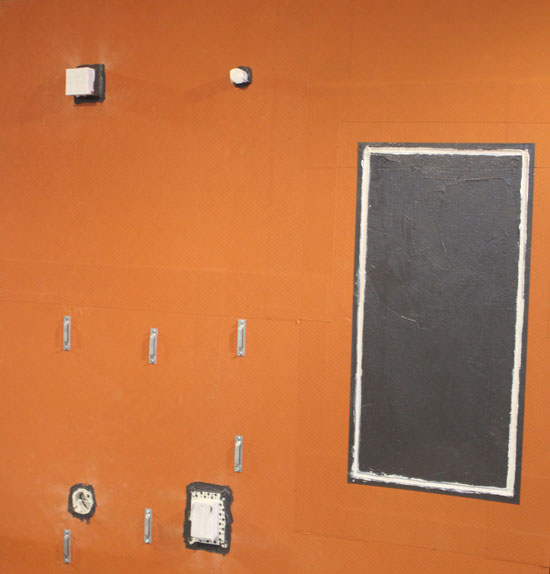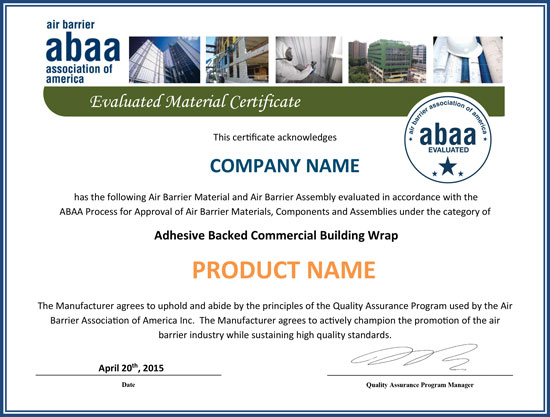Breaking Old Rules for Air-Barrier Installation
Performance and Testing of Breathable, Self-Adhearing WRB/Air Barriers
In the design and build industry, this new class of breathable, self-adhering weather-resistant barriers/air barriers is getting attention. Such a product, with extra UV protection for use in open joint applications, was recognized as a 2014 Record Product by Architectural Record, one of only 15 winners in the Facades category. In announcing the award, the judges listed the product’s attributes as: a black, UV-stable, water-resistive, vapor-permeable air-barrier membrane for open-joint rainscreen cladding, the zero-VOC membrane installs in a single layer in temperatures as low as 20 degrees Fahrenheit. The Class A fire-rated material has a Flame Spread Index of 0, and is highly vapor permeable, reducing incidence of mold, mildew, and rot.

Photo courtesy of VaproShield
An assembled system is tested according to criteria set forth by the performance guidelines of an assembled system.
The guaranteed efficacy of these products depends on reliable testing methods. The ASTM E2357: Standard Test Method for Determining Air Leakage of Air Barrier Assemblies measures the performance of an assembled system rather than the amount of air leakage through a single component. The installed assembly is tested under a multitude of negative and positive air pressures, including extreme wind gust load conditions.
The ASTM E2357 test method measures and compares the air leakage through an opaque, non-penetrated wall assembly against the air leakage through a wall assembly with pipe penetrations, brick ties, electrical boxes, foundation transitions, and lap seams and flashings. The walls are subjected to extreme positive and negative wind-load conditions and the measured air leakage recorded. If the measured air leakage rate passing through the wall with penetrations is greater than 10 percent of the opaque wall, the assembly fails. A passing grade for this test indicates the quality of the system to ensure the installation as provided will be airtight.
ASTM E2357 Differs From Previous Test StandardsIt’s important to note that while codes regulate air-leakage rates or limits, test methods verify the performance characteristics. The more common requirement for acceptable air leakage rate for a membrane is set at 0.004 cfm/ft2 at 1.57 psi of air pressure (0.02 L/s m2 @ 75 Pa). One such test method used is ASTM E2178: Standard Test Method for Air Permeance of Building Materials. In addition to flexibility, tensile strength, and a few other durability tests, it measures the air permeance of individual materials, but only to 1.57 psi (75 Pa) of air pressure. With the introduction of ASTM E2357, it is realized most building projects experience significantly higher wind loads, both negative and positive than 1.57 psi (75 Pa). ASTM E2357 verifies the air-barrier system approach will stand up to the extreme weather conditions a building enclosure may experience during its lifetime. The ASTM E2357 test is also a far more realistic test because it includes multiple penetrations like a real building. The ASTM E2178 test is simply for materials, which is unrealistic because buildings always have penetrations.
At least one company uses the ASTM E398 test to evaluate vapor permeance of the membranes. This testing technology, invented more than 20 years ago for use by the packaging and medical industries, allows for faster, more precise measurements than the traditional ASTM E96 testing methods, while still allowing for comparison with ASTM E96 WVT (Water Vapor Transmission) values.

Image courtesy of VaproShield
In response to the latest technologies, the Air Barrier Association of America created a new category for certification titled Adhesive Backed Commercial Building Wrap.
Approval by Air Barrier Association of America
The Air Barrier Association of America (ABAA) is the premier organization that verifies and approves the effectiveness of air barriers. Products should have this approval for optimum results in the building enclosure. In April of 2015, ABAA approved membranes are fully self-adhered, water-resistive barriers and air barriers with a cutting-edge adhesive that does not require primers, is void of VOCs, and can be applied in below freezing temperatures. The reason this is remarkable is that an ABAA category for such innovative products did not previously exist, and thus a new category was created for Adhesive Backed Commercial Building Wrap. This presents further evidence that the design and manufacture of air barriers continues to evolve.









